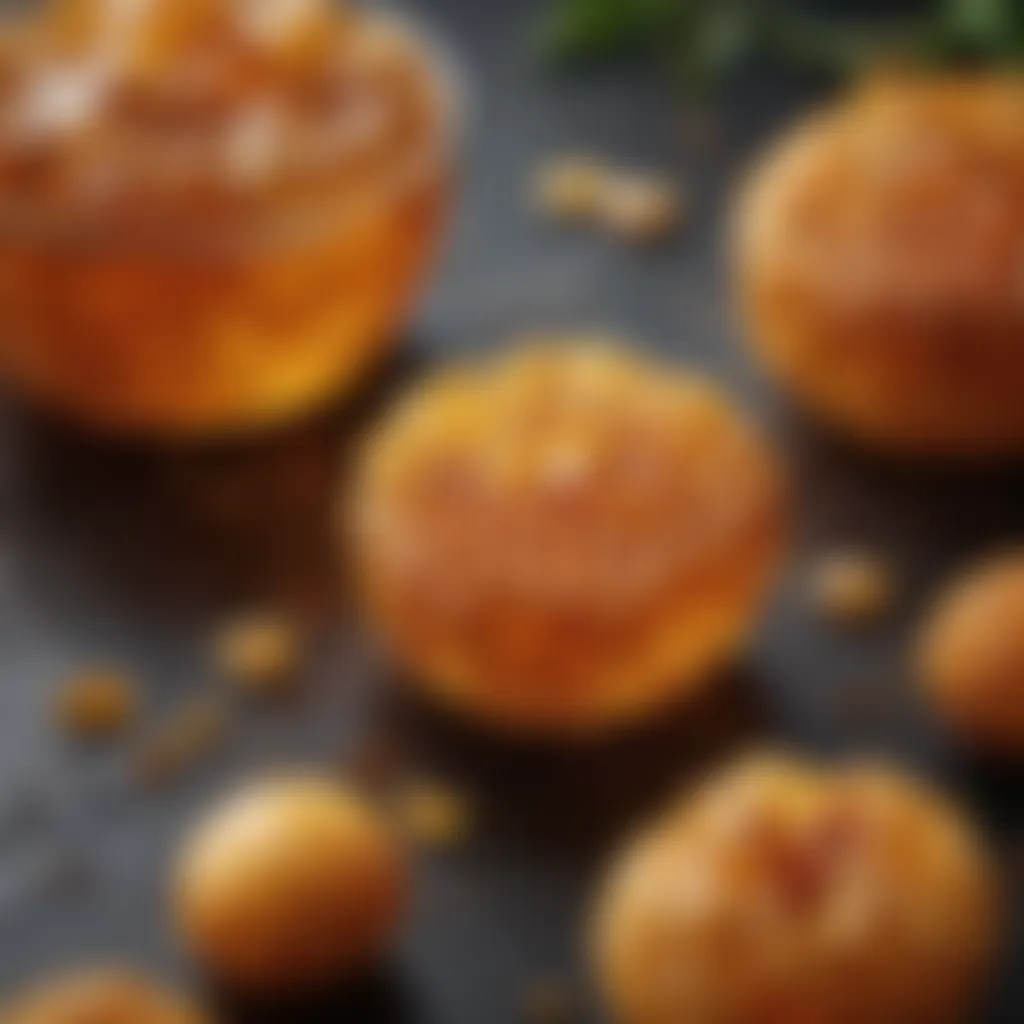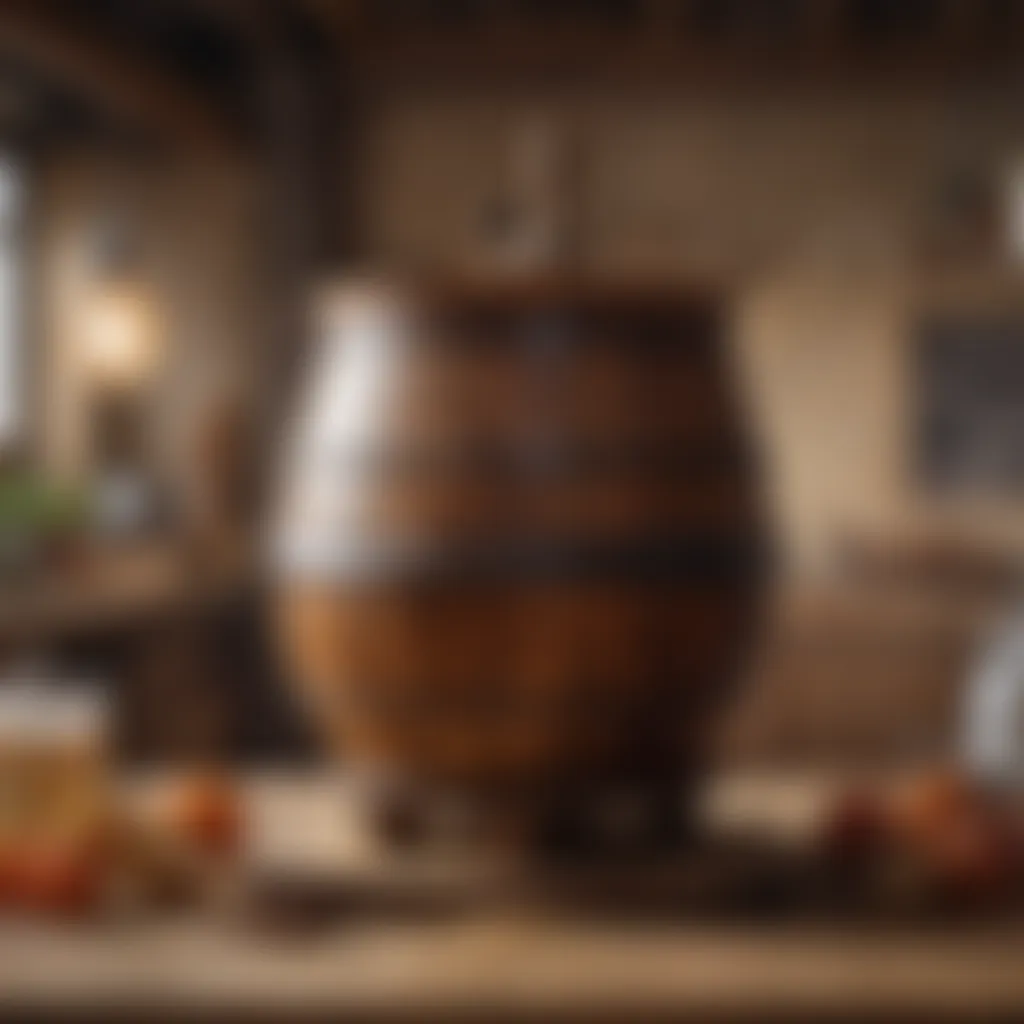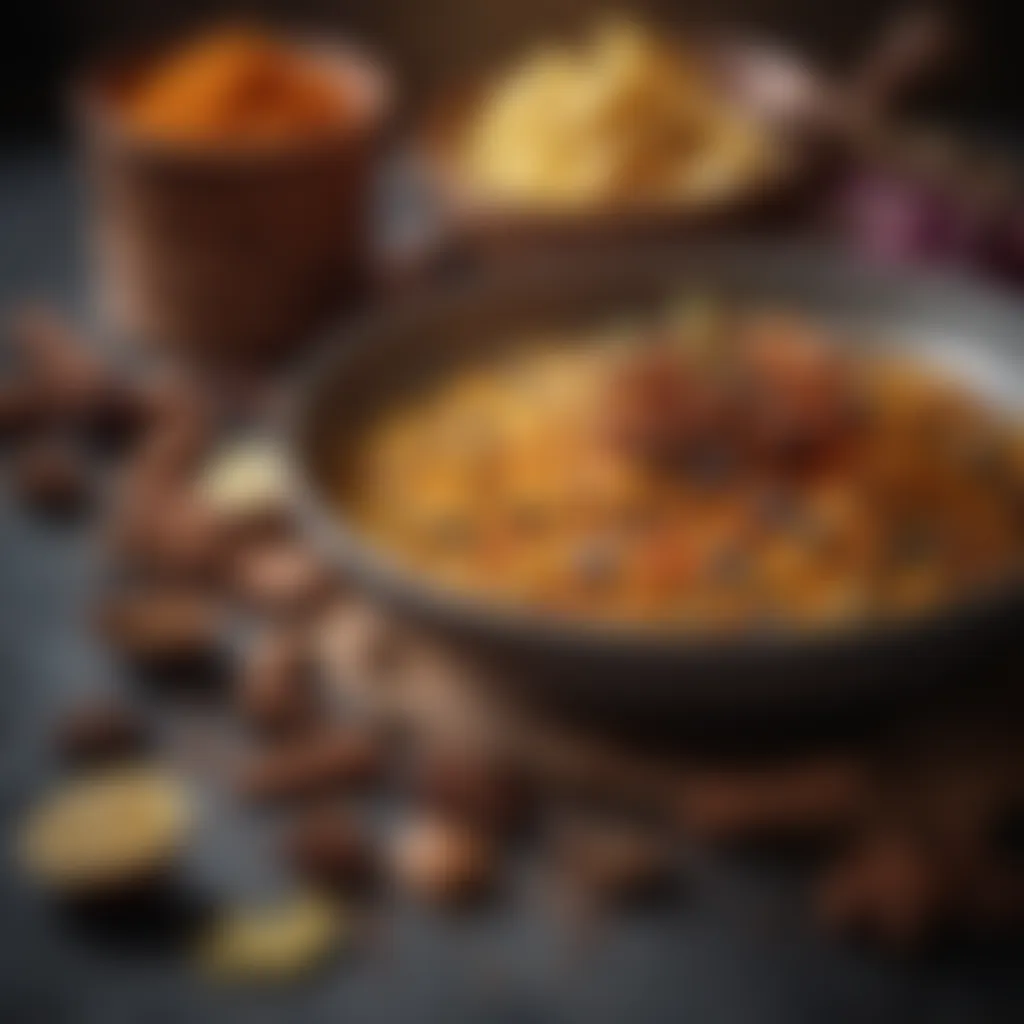The Art and Tradition of Danish Mjod Crafting


Intro
Diving into the world of Danish mjod is like taking a step back in time, where tradition blends seamlessly with craft. This ancient mead, with roots stretching deep into the past, showcases more than just its sweet, intoxicating flavor. It's a testament to a culture rich in history and community bonds.
Crafting mjod isn't just about throwing together ingredients; it’s an art form. From the ancient practices of the Vikings to today's modern interpretations, the journey of mjod encompasses a myriad of flavors, techniques, and stories. Many housewives today might find joy and fulfillment in embracing this age-old craft, creating something that connects them to a century-old tradition.
In this guide, we’ll peel back the layers of mjod making to reveal everything, from the essential ingredients to the precise methods that will help you make a batch worthy of the finest feasts. So, whether you’re looking to impress friends at your next gathering or simply enjoy a sip of history, let’s get started!
Ingredients:
To kick off your mjod brewing adventure, here’s a comprehensive list of the ingredients you’ll need. Getting these right is crucial for the perfect balance of flavor.
- Water: 4 liters (filtered or spring water is recommended)
- Honey: 1.5 kg (choose a light, floral honey for a more aromatic flavor)
- Yeast: 5 grams (champagne yeast or mead yeast works best)
- Herbs and spices (Optional): 20 grams each of your choice (like cinnamon or chamomile for flavor)
- Fruits (Optional): 500 grams (like berries or citrus to enhance taste)
Detailed Instructions:
Before you start, ensure all your equipment is sanitized thoroughly to prevent any unwanted bacteria.
- Prepare the must: Begin by heating about half of your water (2 liters) in a large pot. Do not boil it; you just want it warm enough to dissolve the honey.
- Dissolve the honey: Once the water is warm, slowly stir in the honey until it’s fully dissolved. This mixture is called the "must".
- Add more water: Pour in the remaining cold water (2 liters), which will help cool down the must. The ideal temperature for fermentation is around 20-25°C.
- Fermentation setup: Once your mixture has cooled to the desired temperature, transfer it to a sanitized fermentation vessel.
- Yeast activation: In a small bowl, mix the yeast with a bit of warm water (not hot) and let it sit for about 5-10 minutes until frothy. Then, add it to the must.
- Flavor additions: If you’re using herbs, spices, or fruits, now’s the time to add them to the fermentation vessel.
- Seal the vessel: Attach an airlock to the top of the fermentation vessel and place it in a dark, moderately warm area.
Technical Aspects:
Keeping an eye on temperature and timing throughout the fermentation process is vital.
- Temperature settings: Maintain a steady temperature between 20-25°C. Too hot or too cold and your yeast may not perform well.
- Timing specifics: Primary fermentation typically lasts about 2-4 weeks. You can tell it’s done when the airlock stops bubbling.
Cooking Process:
- Racking the mjod: Once fermentation has slowed, carefully siphon the mjod off the sediment into another sanitized vessel. This step is crucial to avoid any off-flavors.
- Secondary fermentation: Allow the mjod to sit for another month. This aging process really brings out the flavors.
- Bottling: After the aging period, it’s time to bottle your mjod. Use dark glass bottles to protect it from light, which can change the flavor.
- Corking: Seal tightly, and store in a cool, dark place. It can be consumed young, but for even better taste, let it age for several months.
Troubleshooting Tips:
While brewing mjod can be a joy, a few hiccups might come along.
- Foam overflow: If it’s bubbling too vigorously, you may need to move the fermentation vessel to a larger container.
- Slow fermentation: If bubbling is sluggish, check the temperature. Yeast activities best in warmer environments. If still slow, consider adding more yeast.
- Off-flavors: If mjod tastes off, it might hint at contamination or the choice of honey. Ensure your equipment is well-sanitized.
Remember, the beauty of mjod lies in its flexibility. Experiment with different flavors and techniques until you find what delights your palate!
Let’s take this journey into mjod brewing further, ensuring you can craft a drink that connects us to the past while celebrating present tastes.
Historical Background of Mjod
The journey into the world of Danish mjod begins with its historical backdrop. Understanding the roots of mjod is essential not just for appreciating its flavor but also for grasping its cultural significance. The craft of mjod brewing weaves a rich tapestry, connecting past and present, tradition and modernity. The stories behind this beverage are as intoxicating as the drink itself, making it a vital part of Danish heritage.
Origins of Mjod
Mjod, typically known as mead in English, can trace its origins back to ancient times. The earliest references harken to a civilization that thrived more than three thousand years ago. In the Nordic regions, mjod emerged from a blend of honey and water, often infused with various herbs and spices. This brew was not simply a drink; it served as a ceremonial libation, part of both rituals and social gatherings. The Norse mythology often featured mjod, as stories of gods and warriors intertwined with its consumption, demonstrating its importance beyond mere refreshment.
The remarkable aspect of mjod is how it reflects the geography of Denmark. The bees that produce the honey relied on the natural flora, making each batch unique and deeply rooted in its region. The different flowers the bees visited contributed to nuances in taste. Thus, each local mjod recipe encapsulates its environment, a true testament to the landscape of Denmark.
Mjod in Ancient Danish Culture
In ancient Danish culture, mjod was not just for quenching thirst; it was a significant marker of hospitality and celebration. Gatherings often featured mjod, uniting friends and family, and bridging gaps between social classes. In fact, it was sometimes reserved for special occasions, embodying triumphs, marriage, and fertility rites. People believed that sharing mjod spread warmth and unity, cementing bonds of kinship.
Moreover, this beverage frequently found its way into Viking lore. As the brave explorers journeyed across the seas, mjod remained their steadfast companion, fueling their spirit for adventure. Artifacts and remnants from burial mounds suggest that it played a role in funerary rites, as well. The belief was that mjod would accompany the deceased in the afterlife, ensuring their journey was harmonious.
Cultural Significance in Literature
Mjod's presence in literature is another testimony to its cultural weight. From the poetic verse of the Edda to the prose of later centuries, mjod has appeared in countless tales representing joy, creativity, and deep connections to the divine. Notably, poets often used mjod as a metaphor for inspiration, with the phrase "mjod of the poets" reflecting its essence as a muse for creativity.
Throughout history, mjod also symbolizes the passing of knowledge and tradition. As stories were recited over a cup of mjod, wisdom was shared, lessons were learned, and community wisdom was preserved. The act of drinking mjod became synonymous with storytelling, making its presence felt in both oral and written records.
"To share mjod is to share life—its sweetness, its intensity, and its echoes of history."
Ingredients of Danish Mjod
When it comes to crafting Danish mjod, the choice of ingredients is paramount. Each element plays a significant role in developing the beverage's unique flavor, aroma, and overall quality. For those stepping into the world of mjod brewing, understanding these ingredients becomes not just a matter of importance; it's an essential journey into the heart of the craft itself.
Types of Honey Used


Honey is the cornerstone of mjod production, and its selection cannot be overstated. Various types of honey impart different flavors and characteristics to the final product. For example, wildflower honey often leads to a bright and floral end profile, while buckwheat honey tends to lend a robust, earthy tone. Choosing the right honey isn’t about picking the fanciest jar off the shelf; it’s about recognizing the subtleties of flavor and how they interplay with other ingredients.
Often overlooked is the fact that the sourcing of honey impacts not just the taste but also ethical considerations. Many local beekeepers create specialty honeys which enhance the taste and give the mjod a regional flair, emphasizing the importance of supporting local agriculture.
Herbs and Spices Contributing to Flavor
Beyond honey, the addition of herbs and spices in mjod elevates the drink to a whole new level. Common choices include cinnamon, cloves, and ginger. Each preserves an aging tradition of flavoring mjod while adding its unique kick. For instance, a dash of cardamom can whisk the mjod straight into warm, cozy territories, reminiscent of a winter's evening.
Consider experimenting: rosemary might not be the first go-to in mjod brewing, yet it crafts a distinct herbal note that can be utterly refreshing. These choices also give room for personalization, allowing brewers to express their creativity and preferences.
Use of Fruits in Mjod
Fruits play an integral role in many mjod recipes, introducing vibrant flavors that dance on the palate. Apples, pears, and berries can offer a delightful sweetness while balancing out the inherent tartness that can develop during fermentation. Over the centuries, brewing legends have emerged around odd combinations such as elderflower or even citrus fruits; these embellishments can create astonishingly unique variations of mjod.
To fully exploit the fruity potential, one may consider using fresh fruits during fermentation. The result can be surprisingly uplifting, merging sweetness with the characteristic fermented essence, creating layers of flavor that tell a story of its origin.
Water Quality and Its Impact
One often-neglected factor in mjod brewing is water quality. Yes, water is the unsung hero behind the scenes. Clean, fresh water can foster a conducive environment for fermentation, while hard water with high mineral content can overwhelm the more delicate flavors—especially those essential honey notes.
When brewing mjod at home, consider performing a quick check on your tap water or, better yet, opt for filtered water. This small but critical step can lead to a noticeably cleaner, more refined final product. It's worth noting, too, that the temperature and mineral composition can profoundly affect fermentation timing and efficiency.
"The journey of flavor begins with selecting the right ingredients; the deeper the roots in quality, the stronger the craft becomes."
Brewing Techniques
Brewing techniques are at the heart of crafting Danish mjod, the process defining its flavor, aroma, and overall character. Understanding these techniques is essential not only for achieving a delightful end product, but also for connecting with a tradition that stretches back centuries. The choices a brewer makes regarding techniques can significantly affect the final taste and quality of the mjod. Additionally, appreciating these methods provides insights into the rich history and culture that surrounds this beloved beverage.
Traditional Brewing Methods
In many ways, traditional brewing methods serve as the backbone of mjod production. These techniques were often passed down through generations, each adding their own flair and personal touch to the recipe. Traditionally, mjod was brewed in small batches, utilizing local ingredients to create unique flavors specific to the region.
Some of the hallmarks of traditional mjod brewing include:
- Use of natural honey: The primary sweetener, sourced from local beekeepers, gives mjod its distinctive character.
- Infusions of herbs and spices: Ingredients like thyme, cinnamon, and cloves infuse the mjod with rich flavors.
- Open fermentation: This age-old practice allows wild yeast to contribute to the fermentation process, making for a more complex taste.
These methods evoke a connection to the land, emphasizing the importance of high-quality, local ingredients.
Modern Adaptations of Mjod Brewing
As times change, so does the craft of mjod brewing. Modern adaptations bring new techniques and technology into play, expanding possibilities for home brewers and craft breweries alike. With today’s resources at hand, the complexity and flavor profile of mjod can reach new heights.
Some modern innovations include:
- Controlled fermentation environments: Utilizing fermentation chambers allows stronger control over yeast activity and temperature, leading to more predictable outcomes.
- Creative flavor infusions: Introduction of fruits, flowers, and even spices unknown to traditional recipes allows for experimentation.
- Advanced bottling techniques: Modern bottling technologies help with preservation and ease of consumption.
These adaptations keep the spirit of mjod alive while introducing flavors that can attract both new enthusiasts and seasoned drinkers.
Fermentation Process Explained
Fermentation is where mjod transforms from a mixture of honey, water, and additional ingredients into the final alcoholic beverage. This crucial step influences flavor, clarity, and overall quality. During fermentation, yeast consumes the sugars in honey and converts them into alcohol and carbon dioxide.
A few points worth noting about the fermentation process include:
- Duration: Depending on the recipe and the desired outcome, fermentation can take anywhere from one to several months.
- Temperature control: Keeping an eye on temperature helps prevent unwanted flavors from developing.
- Monitoring specific gravity: This measurement helps brewers determine when fermentation is complete, ensuring a perfect balance of sweetness and alcohol.
In summary, this process is not just biological; it’s an art form requiring patience and attention.
Aging and Storing Mjod
Like fine wine, mjod benefits from aging after fermentation. This allows the flavors to meld and mature, resulting in a smoother, more refined product. Understanding how to properly age and store mjod is essential to achieving the best results.
Considerations for aging mjod include:
- Containers: Use glass or food-grade plastic to avoid altering flavors.
- Temperature and light: Consistency in temperature and protection from direct sunlight can prevent spoilage and oxidation.
- Timing: While some mjods are best enjoyed young, others can age beautifully for years. The brewer should taste periodically to gauge the process.
Ultimately, aging and storage practices reflect the care taken in brewing. So, maintaining good conditions can elevate the craft into something exceptional.
"The magic of mjod lies in the journey from humble ingredients to a complex beverage; the brewing techniques hold this transformation in their hands."


Health Implications of Mjod
The relationship between mjod and health is more intricate than one might assume at first glance. It’s not just about the taste or the traditional significance; the health aspects of mjod are equally compelling. For those who wish to understand how this ancient beverage fits into modern lifestyles, examining its nutritional benefits, potential health contributions, and guidelines for moderate consumption is crucial. By doing so, one can enjoy mjod as a thoughtful addition to one’s diet, rather than just a drink.
Nutritional Aspects of Mjod
At its core, mjod is fundamentally natural. The primary ingredient, honey, is a well-known natural sweetener packed with essential vitamins and minerals. It includes antioxidants like flavonoids, which can contribute to overall well-being. Alongside honey, mjod can incorporate various fruits, herbs, and spices, further enriching its nutrient profile.
When making mjod, consider the type of honey used. For instance, wildflower honey contains a plethora of beneficial compounds, while clover honey may lean toward a milder taste but still packs a nutritional punch.
Here are some nutritional highlights of mjod:
- Antioxidants: Helps fight oxidative stress in the body.
- Vitamins: B vitamins, like B6, niacin, and riboflavin, appear in various types of honey.
- Minerals: Includes trace minerals such as zinc and selenium.
- Natural sugars: Provides a quick source of energy.
Consuming mjod in moderation can be a way to gain these benefits while enjoying its rich flavors.
Potential Health Benefits
Beyond its nutritional components, mjod has been noted for several potential health benefits for ages. Some of these benefits align with the growing interest in natural remedies for common ailments. Here are few aspects to consider:
- Digestive Aid: The natural sugars and enzymes in mjod can aid digestion. Some even believe that mjod acts as a probiotic, promoting gut health.
- Immune Booster: The antioxidants found in mjod can contribute to a stronger immune system.
- Soothing Properties: Mjod has been traditionally consumed by those with sore throats, functioning as a soothing syrup. It can help alleviate discomfort, primarily when combined with herbs like ginger.
Health is not just about avoiding illness; it's about nourishing the body with natural products.
Furthermore, the psychological aspect of enjoying mjod should not be overlooked. Any opportunity to indulge in a tradition can foster a sense of well-being and relaxation.
Alcohol Content and Consumption Guidelines
Like many fermented beverages, mjod contains alcohol. The alcohol content can span from low to high, depending on the brewing process and fermentation duration. Generally, most mjod varieties contain between 8% to 12% alcohol by volume.
When enjoying mjod, moderation is key:
- Women should limit their intake to one glass, while men may consider two, in a single sitting.
- Remember, mjod can be deceptively smooth, making it easy to consume more than intended.
- Consider the context: Drinking mjod during meals can slow absorption and mitigate some effects.
Furthermore, always consult with a healthcare provider if you have underlying health issues or are considering significant changes to your consumption habits.
Food Pairings with Mjod
When it comes to enjoying Danish mjod, the right food pairings can elevate the experience significantly. Mjod, with its sweet and hearty character, complements a variety of dishes, enhancing flavors and creating a memorable dining experience. The importance of food pairings lies not only in boosting the taste but also in creating a harmonious background that allows each element—food and mjod alike—to shine.
Traditional Danish Dishes
There’s no denying that mjod is deeply rooted in Danish culinary traditions. When exploring traditional Danish dishes, pairing them with mjod can unlock flavors that might otherwise go unnoticed.
- Smørrebrød: These open-faced sandwiches are classic. Topped with herring, liver pâté, or cheese, they bring savory richness that balances mjod's sweetness. The buttery rye bread acts as a perfect base.
- Frikadeller: Danish meatballs, often served with potatoes and gravy, pair nicely with mjod. Their hearty flavors and mjod’s honeyed notes mesh well, creating a comfort food phenomenon.
- Rødgrød med Fløde: This traditional Danish dessert is a fruit porridge served with cream. The sweet and slightly tart elements of the dessert create an ideal contrast to the honeyed profile of mjod.
International Cuisine Pairings
Danish mjod is not just limited to its national cuisine. The beauty of mjod lies in its versatility, making it suitable for diverse international dishes.
- Spicy Asian Cuisine: Think Thai or Vietnamese dishes. The sweetness of mjod can help temper spiciness in foods like spicy curry or fried spring rolls.
- Mediterranean Delights: Dishes like grilled lamb or chicken shawarma offer earthy flavors that resonate with the complexity of mjod. These meals often feature herbs that complement the herbal nuances in certain mjod recipes.
- Sushi: Surprisingly, mjod can be a delightful companion to sushi rolls, especially those with sweet or spicy elements. The clean, fresh flavors of sushi harmonize well with sweet profiles.
Cheese and Charcuterie Suggestions
Cheese and charcuterie boards are popular for casual gatherings, and mjod can enhance this experience. Consider these combinations for your next cheese platter:
- Blue Cheese: The sharpness and creaminess of blue cheese contrast beautifully with the sweetness of mjod.
- Aged Gouda: Its nutty and caramel notes align well, creating an indulgent experience.
- Serrano Ham: This Spanish cured ham, with its rich flavor, pairs seamlessly with mjod's notes.
"The right pairing can transform a meal from ordinary to extraordinary."
Mjod in Contemporary Culture
The rebirth of Danish mjod in recent years paints a vivid picture of how traditional practices can find a solid foothold in the modern world. Once considered an ancient drink primarily for special occasions, mjod has now re-emerged, capturing hearts and taste buds alike. This transformation not only illustrates a commendable respect for tradition but also invites a fresh audience to experience a slice of Denmark’s rich cultural heritage.
Revival of Traditional Brews
In a world where craft beverages are gaining prominence, the revival of traditional brews like mjod is significant. Many people today are looking for authentic experiences, and brewing mjod connects them with their roots. This resurgence taps into a curiosity about ancestral practices and an interest in making things by hand. You might walk into a homebrew store and find shelves lined with mjod kits, each promising a taste of history in your glass.
When crafting mjod, enthusiasts often research age-old recipes or even consult local elders who might still hold the culinary secrets passed down through generations. It’s a way to honor the past while savoring the fruits of their labor, often resulting in unique flavors bred from personal touches and local ingredients. From honey sourced directly from nearby beekeepers to herbs picked during a summer stroll, each batch tells a story.


Mjod in Modern Celebrations
Celebrating milestones with mjod has taken off, as it’s not just a drink. Rather, it embodies camaraderie and joy. People are using mjod for everything from weddings to birthdays, breathing life into traditional toasts. Improvisation has become the name of the game, and home brewers are experimenting with exotic ingredients like hibiscus petals or chili peppers, adding a modern twist that appeals to adventurous palates.
"The art of mjod helps transform a simple gathering into a revelry steeped in culture."
Here’s what you can expect at contemporary celebrations:
- Personalized Flavors: Custom blend options make every batch a reflection of individual tastes and preferences.
- Sustainable Choices: With an emphasis on local sources, making mjod can resonate well with environmentally-conscious hosts who prioritize green practices.
- Storytelling Aspect: Serving homemade mjod sparks conversations around its history, fostering connections among guests.
Craft Mjod Breweries
As the spotlight shines on craft beverages, several microbreweries have sprung up, focusing on mjod production. These establishments are pushing the envelope, creatively blending diverse flavors while staying true to traditional brewing practices. A visit to a craft mjod brewery might involve guided tastings and tours of the brewing process, putting a spotlight on how they blend artistic talent with time-honored techniques.
Some notable characteristics of these craft mjod breweries include:
- Experimentation: Infusing flavors like rosemary, orange zest, or even locally grown fruits gives them a unique edge and fosters bold flavor profiles.
- Community Involvement: Many craft breweries prioritize local customers and engage them through events or workshops, strengthening community ties.
- Education and Workshops: Some breweries offer homebrewing classes, allowing enthusiasts to gain firsthand experience while demystifying the brewing process and stoking their passion for mjod.
In summary, mjod has transformed into a cultural touchstone that honors its roots while welcoming new energy and experimentation. This drink is not merely a beverage; it's a reinstatement of stories, community, and culinary art, providing an important bridge between traditions past and the evolving tastes of today.
Practical Guidelines for Home Brewing
Brewing mjod at home is not just an enjoyable activity, but it also creates a deep connection with a tradition that has spanned centuries. Crafting your own mjod offers customization and a unique way to experiment with flavors. Home brewing allows you to adapt the taste profiles to your preferences, be it honey type or additional spices. This section provides a comprehensive approach to ensure a successful brewing journey, breaking it down into essential components—from ingredient selection to the final tasting.
Choosing the Right Ingredients
When embarking on the home brewing adventure, selecting quality ingredients is paramount. Honey is the foundation of mjod, and thus, its type greatly influences the flavor. Raw and unprocessed honey from local beekeepers often offers the richest taste. You might explore varieties like clover, wildflower, or even heather, each contributing distinct notes.
- Honey Variants: Different honeys can lend your mjod sweetness and floral notes. For instance, buckwheat honey is robust and dark, while orange blossom honey adds a lighter, citrus tone.
- Herbs and Spices: Consider incorporating herbs like juniper berries or chamomile. These not only enhance flavor but may also offer potential health benefits.
- Fruits: Adding fruits such as apples or berries can increase complexity. They can also provide natural sweetness and a beautiful hue.
- Water Quality: Don’t overlook the importance of water—use purified or spring water to avoid chlorine and impurities. Your mjod will only be as good as the components you use.
Essential Equipment for Brewing Mjod
Home brewing doesn't require a mini brewery setup, but having the right tools can make a significant difference. Here’s what you will need:
- Fermentation Vessel: A clean glass carboy or a food-grade plastic bucket with an airlock.
- Stirring Spoon: A long wooden or plastic spoon for mixing your ingredients.
- Hydrometer: To check the sugar content and potential alcohol level.
- Bottles: Clear glass bottles for storing your finished mjod—consider using swing-top bottles for an easy seal.
Having the right setup is crucial, but cleanliness is just as important. Ensure everything is sanitized properly to prevent contamination, which could spoil your batch.
Step-by-Step Brewing Process
Here’s a simple brewing process to get you started:
- Prepare Your Ingredients: Measure out the honey, water, and any additional flavor elements (fruits, herbs).
- Mix: Dissolve the honey in warm water (around 120°F). Allow it to cool before adding more water.
- Add Yeast: Once cooled, stir in your yeast. It’s essential to follow the manufacturer's instructions regarding amounts and activation.
- Fermentation: Transfer the mixture into the fermentation vessel. Seal it with an airlock and place it in a dark, temperature-stable area. Fermentation can take from a week to several months, depending on the desired taste.
- Bottling: Once fermentation has halted (no bubbles in the airlock), it’s time to bottle. Carefully siphon the mjod into sterilized bottles.
- Aging: Let it age for several weeks to a year. Longer aging will generally improve flavors.
Troubleshooting Common Issues
Brewing, like any craft, can encounter hiccups. Here are some potential issues and their remedies:
- Undesirable Taste: Sometimes fermentation can lead to unexpected tastes. If your mjod is overly sour, it may have been contaminated. Always use sanitized equipment.
- Inactivity of Yeast: If fermentation doesn’t start within a few days, consider temperature or yeast health. Ensure it’s a warm environment, and try to repitch fresh yeast.
- Over-carbonation: If too much carbonation occurs, simply poke a small hole in the top of each bottle to release excess pressure.
“Patience is the key in brewing. Each batch teaches you something new.”
Embarking on the journey of mjod brewing at home not only allows creative expression but also delivers a sense of accomplishment when you finally taste the fruits of your labor. Following these practical guidelines helps ensure that your experience is enjoyable and educational.
Culmination
The discussion of Danish mjod culminates in an appreciation for both its history and its modern significance. This conclusion not only encapsulates the essence of mjod but also underscores the multifaceted aspects that make it a remarkable beverage. From its ancient origins to the revival of traditional brewing techniques today, mjod serves as a bridge connecting the past with the present.
The Enduring Appeal of Mjod
Vamos a poner esto en perspectiva. The pull of mjod lies not just in its flavor but in the stories it tells. Each glass holds a piece of history, resonating with whispers of the past where it was celebrated at feasts and festivals. This deep-seated cultural heritage enhances its appeal across generations. Consider this: in a world constantly chasing the new, mjod stands out as a reminder of simpler times. It’s not just a drink; it’s an experience.
- The honey base imbues it with a sweetness that many find nostalgic.
- The diverse flavors from herbs and spices offer a complex profile, making every sip a little adventure.
Moreover, the health aspects can’t be overlooked. Many say that a moderate amount of mjod is good for the heart and digestion, adding another layer to its charm. Consumers increasingly seek products with health benefits, making mjod a natural contender in the evolving market of artisanal beverages.
Encouragement to Explore Brew Options
For those feeling a bit adventurous, there’s a vast ocean of opportunities to explore in home brewing mjod. Experimentation with ingredients not only charms the palate but also allows for personal expression within each brew. Whether it’s mixing in various fruits for a unique twist or trying out different honey types, the sky's the limit.
- Trial and Error: Don’t shy away from mistakes—the best recipes often come from failed attempts.
- Resource Gathering: Tap into communities, share experiences on platforms like reddit.com or find local hobbyists on Facebook groups.
In essence, each home brewer has the chance to create their own signature drink, making the experience all the more rewarding. This prospect of crafting something personal encourages not just participation in a time-honored tradition, but an opportunity to share that creation with family and friends, further enriching your gatherings.
Thus, the journey of understanding, crafting, and enjoying mjod is not just a hobby, but a revitalization of culture—an invitation to partake in something deliciously ancient, yet vibrantly alive today.







